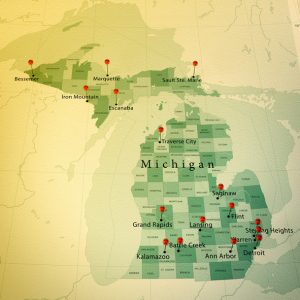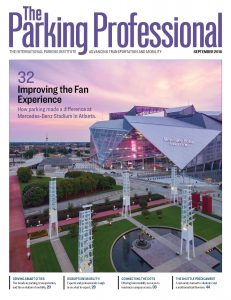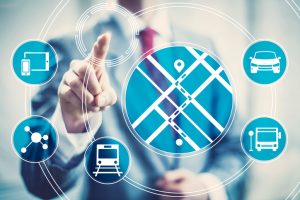By Trevyr Meade, LEED GA
 IPMI’s Parking Research Committee convened experts and professionals and invited them to weigh in on what to expect in transportation, shared mobility, and effecting positive change.
IPMI’s Parking Research Committee convened experts and professionals and invited them to weigh in on what to expect in transportation, shared mobility, and effecting positive change.
WE HEAR A LOT ABOUT MOBILITY—the ability to get from place to place—especially in cities. But what do trends in transit, shared rides and vehicles, and alternate modes of transportation mean for parking organizations? IPI’s Parking Research Committee asked some of the industry’s top experts for their opinions.
During the next 10 years what will be the biggest driver of change in our transportation systems?
Gary Lawrence: I think there will be three major drivers of change in our mobility and access systems. First will be the degradation of existing infrastructure with insufficient funding to replace it while also embedding needed communications architecture. The second will be a shift from fossil to alternative fuels. And there will be increases in urban congestion in surface transportation system, requiring multidimensional thinking.
Chris Atkins: The biggest drivers will be the rise of the sharing economy, its effects on driving, as well as the rise of autonomous and electrically powered vehicles. Also, from a technology perspective, the continued rise of digital transformation using data to design new models of citizen mobility.
Robert Ferrin: Mobility behavior enabled by innovation will be the biggest driver in our transportation system. Conventional norms on how we access place are rapidly changing, spurred by shared-mobility providers and instant information at your fingertips. Owning a car is no longer a necessity in locations where good public transit is coupled with robust car- and bike-share, dynamic shuttle systems, and other shared-mobility providers. As mobility behavior continues to change, it is important we create forward-thinking policies and programs to encourage the efficient movement of people and goods to support the growth of our communities.
Diana Alarcon: For South Florida, it will be the development of a regional mass transportation system. Our current mode of transportation in South Florida is a car. The three regional counties are currently working with the local transit agency on developing a mass transportation system of moving folks through all three counties. As these transitions occur, it will be the local cities’ challenge of that first/last mile travel. That is using all modes: walkability, bicycle, ride-sharing, car, car-sharing, trolley, bus and modern street car. And the biggest challenge will be: How do we make it work with the limited right-of-way available and curb to manage the traffic flow?
Joachim Hauser: The biggest driver for change will be digitalization indeed. There is no other technology around the block that will have more influence. Decision-making by each driver and individual will be accomplished by city-wide fleet management and in-car traffic management, observing singular movements of cars, and managing traffic in a wider city-appropriate manner.
What should parking and transportation professionals know about shared mobility? What effects will shared mobility have on parking?
David Stein: The effects of shared mobility are real, but at the same time, there is still a great unknown in what the end results will be regarding parking. Adoption rates, investment in new technologies, and varying approaches to these emerging concepts mean there is no one-size-fits-all model and each municipality, region, or country will have already experienced different impacts to date. However, I think there is some consensus that as shared mobility begins to rise, the demand for parking will decrease and the way we think about parking will change. Accordingly, we should be proactive and resolute in our approaches and response to the emerging and evolving system.
Robert Ferrin: In our urban centers, shared-mobility providers are offering a new way to get from point A to point B that does not include taking traditional transportation options such as public transit or a single-occupancy vehicle. These providers are having profound effects on our industry. For off-street providers, shared mobility is, in some cases, driving down parking demand and forcing operators to think differently about how they allocate spaces and permits to users. For on-street providers and regulators, shared-mobility providers are changing the way we allocate curb lane space beyond the traditional uses such as taxis, limos, and metered parking spaces. Flexible use of curb lane space is important to maximize limited parking and loading areas.
Joachim Hauser: We know from scientific studies that each car-sharing car is able to substitute for up to seven individual cars. This figure might not be scalable to the entire car park, but there is a clear option to reduce the number of cars in a city. Most of these eliminated cars might have their parking at roadside, and they are seldom used. So this might not affect off-street parking at all. Furthermore, cities might use the chance to reduce on-street parking capacities to the advantage of parking operators. Also, mobility as such does not seem to be close to its saturation yet, which means more options for rides probably will lead to more rides but not to more cars. New opportunities are given by usage of strategically interesting parking locations as mobility hubs.
What current trends are you seeing related to mobility that are disrupting traditional transportation trends?
David Stein: The growth in the ride-hail industry is probably the most prevalent and identifiable trend that’s disrupting traditional transportation throughout the world. First and foremost, the concept and functionality of a taxi has been transformed, and in many places, the ride-hail industry has outpaced and outnumbers the traditional taxi market. It has also changed the way we think about moving from space to space and mobility in general. While car-share has changed our perception of mobility and is viewed as a mechanism to reduce car ownership and use, the pure functionality, cost, and convenience offered by ride-hail vehicles is changing the transportation landscape. For example, a recent article in Crain’s New York Business cites the rise of Uber and Lyft as both a major contributor to congestion while at the same time, discouraging people from driving into the city. Operationally, parking operators are seeing less volume and demand in their facilities, creating what the author calls a “one-two punch” to our transportation system and skewing transportation trends like never before.
Diana Alacorn: Ride-sharing is a game changer in how people move in two ways: It allows someone the flexibility of moving without the responsibility of a car, but at the same time, the number of ride-share vehicles on the roadway is creating more traffic congestion. In time, the market will work through the number of ride-share vehicles that are on the road, but the demand for parking spaces will decrease as less people bring their own cars. Ultimately it may be a wash because reduced parking demand will open up curb space, which can accommodate ride-share queuing to reduce the traffic congestion on city surface streets.
Gary Lawrence: Declines in the quality of infrastructure—roads, rail, bridges—and associated infrastructure such as parking structures are compounding increases in vehicle trips and associated congestion. In addition, online shopping is putting more delivery vehicles on the streets, particularly in dense urban centers. Demand increases coupled with a reduced delivery speed and reduced reliability are causing frustration in many communities.
How do you see the design of parking structures evolving in response to these changes?
Robert Ferrin: Parking garages will need to adapt to new transportation innovations and be more than buildings that house vehicles. Older garages will need to be retrofitted to accommodate connected vehicles or lose their competitive advantage to newer facilities. Revenue-control equipment will need to be flexible to allow for in-vehicle payment and access and share real-time parking availability in an efficient manner. New garages should be designed to accommodate non-parking uses such as housing or office space, as the latest urban infill projects in Columbus, Ohio, are being designed.
Chris Atkins: Large-scale deployment of the internet of things (IOT) and communications infrastructure will generate lots of data. The data will be used to design mobility solutions, including parking, to take advantage of the ability to sense, monitor, and respond in real time. New pricing techniques and unified payment systems will also be designed using this data.
David Stein: With parking operators experiencing less demand, cities are seeing a golden opportunity for redevelopment through the adaptive reuse and/or redevelopment of their parking assets, both surface and garages. With many cities seeing their assets reaching the end of their useful life and limited opportunities for growth, as well as people moving back into cities from the suburbs, there is little point to continued investment in such properties. Cities across the U.S. are seeing these properties transformed into mixed-use development, rich in transit accessibility, and reinvigorating what were once desolate blocks.
How can the parking industry partner with mobility providers and managers to positively effect change?
Diana Alacorn: Parking operators from all branches of the business need to look and recreate the experience for the first and last mile. We work to meet federal, state, and local laws, but we forget to provide the patron an amazing experience. What is that experience? How can we all make it better? What is the customer service that you want to deliver and have your customer experience? What do we need to do to make that experience the best! Working on the first and last mile will be the most important linkage between the parking and mobility industries.
Chris Atkins: Embrace the sharing economy, develop partnerships to enhance the “smartness” of your infrastructure, and view yourself as a critical part of citizen mobility.
Gary Lawrence: I think the parking industry will need to move from being peripheral to mobility problem-solving to a more centralized role bringing together all modes and potential uses for storage and distribution.
Robert Ferrin: Municipal parking leaders should be creating forward-thinking regulations to celebrate and grow these new mobility options for our customers. Setting the stage in the public realm for these transportation options to prosper will lead to additional mobility opportunities for all citizens in our communities. Taking chances with pilot or demonstration projects can test a concept and lead to increased acceptance of mobility options, such as car-share, ride-share, dynamic shuttle systems, and bike-sharing systems.
The effects of shared mobility are real but at the same time, there is still a great unknown in what the end results will be regarding parking.
Read the article here.
TREVYR MEADE, LEED GA, is certification program lead with the U.S. Green Building Council and a member of IPI’s Parking Research Committee. He can be reached at tmeade@gbci.org.
Our Experts
DIANE ALARCON is transportation and mobility department director for the City of Fort Lauderdale, Fla.
CHRIS ATKINS is vice president for digital government transformation at SAP Public Sector.
ROBERT FERRIN is assistant director for parking services with the City of Columbus (Ohio) Department of Public Service.
JOACHIM HAUSER is head of project, automated driving on business ground, with the BMW Group.
GARY LAWRENCE is chief planning and resilience strategist/principal with Enviro Dynamix.
DAVID STEIN is director, parking planning and policy, with the New York City Department of Transportation.
 Lots is changing in the way people get from place to place, and today Forbes says the state of Michigan is at the leading edge of it all.
Lots is changing in the way people get from place to place, and today Forbes says the state of Michigan is at the leading edge of it all.
 It’s not an unfamiliar scenario: A university (or a hospital or an airport or even a municipality) carefully crafts a shuttle system to get people around, factoring in traffic, speed limits, and stop times. And even after agonizing over every detail, the buses still don’t run on time. Argh.
It’s not an unfamiliar scenario: A university (or a hospital or an airport or even a municipality) carefully crafts a shuttle system to get people around, factoring in traffic, speed limits, and stop times. And even after agonizing over every detail, the buses still don’t run on time. Argh.



 By Todd Tucker, CAPP
By Todd Tucker, CAPP